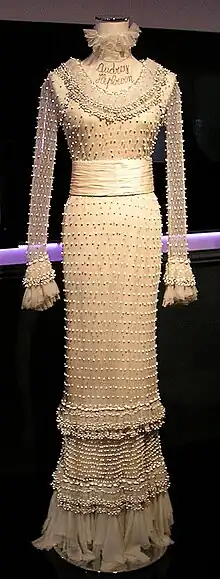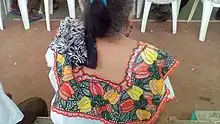
Indigenous fashion of the Americas is the design and creation of high-fashion clothing and fashion accessories by Indigenous peoples of the Americas.
Indigenous designers frequently incorporate motifs and customary materials into their wearable artworks, providing a basis for creating items for the couture and international fashion markets. Their designs may result from techniques such as beadwork, quillwork, leather, and textile arts, such as weaving, twining, and tufting. In some cases, however, they choose not to include any materials associated with Indigenous cultures.
Controversy has emerged over the cultural misappropriation or inappropriate use of cultural heritage and intellectual property by non-Native designers. Respectful use of imagery by mainstream designers who are not Indigenous can help expand appreciation of Native cultures, but plagiarism of design or malapropos use reinforces negative stereotypes and spurs controversy. Similarly, utilizing artisan craftwork can expand awareness if designers are fairly compensated for their work and given credit for their contributions. Contemporary controversies have spurred both crowd-sourced and legislative action to protect the designs and cultural heritage of Indigenous designers.
History

Mid-20th century
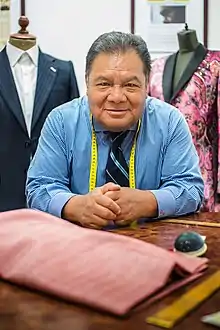
In Mexico before 1950, many Indigenous communities were isolated and produced their own traditional clothing. As roads improved and people began moving from the countryside to cities, many put aside their traditional clothing, to blend in with their new cosmopolitan neighbors.[1] In 1965, Gilberto Ortiz (Mixtec) moved from San Andrés Lagunas, Oaxaca, to Mexico City and began training as a tailor under German businessman, José Schroeder. Acquiring traditional European styling, his first major client was movie icon, María Félix. In 1978, Ortiz left Schroeder and partnered with the Italian businessman, Edmundo Calanchini. He designed mainly for businessmen and politicians until 1997, when he opened his own shop aimed specifically at the haute couture market. In 2006, at the suggestion of his client Juan Gabriel, Ortiz launched his own label, Gioros, an acronym using the first two letters of each of his names, Gilberto Ortiz Osorio. In 2012, he was named one of the top three tailors in the world by the textile firm Scabal. Typically Ortiz produces classically styled garments using high-end fabrics, but his latest offering in 2017 featured men's and women's jeans.[2][3][4]
Sean McCormick (Métis), who began designing footwear in the early 1990s and in 2008, launched Manitobah Mukluks;[5][6] and Virginia Yazzie Ballenger (Navajo), New Mexican designer,[7][8] most noted for her "fluted broomstick skirt and matching velveteen blouse".[9]
Since 1995, the Canadian Aboriginal Festival (CANAB) has hosted a fashion show of First Nations designers. Dave Jones (Garden River Ojibwe), began producing an annual fashion show for the Canadian Aboriginal Music Awards (CAMA) in 2001.[10][11] By 2008, the CANAB Festival featured six fashion shows, as well as booths for designers to exhibit their wares.[12] In 1998, the Denver Art Museum hosted a fashion show, Indian Chic featuring the works of Dorothy Grant, Wendy Ponca, and Margaret Roach Wheeler. It was the first time a major museum had shown works in their collection of Indigenous garments, labeling them as "fashion".[13] Other Native designers of the 2000s include Orlando Dugi (Navajo), Dallin Maybee (Northern Arapaho/Seneca), Connie Gaussoin (Navajo/Picuris Pueblo), the street style of Douglas Miles of Apache Skateboards (San Carlos Apache/Akimel O'odham) and the custom shoes of Louie Gong (Nooksack/Squamish).[14] Dugi is self-taught in fashion, learning to sew, measure and create patterns from online resources.[15] Jamie Okuma (Luiseño/Shoshone-Bannock), another self-taught artist, became the youngest person to earn the Best of Show ribbon at the Santa Fe Indian Market in 2000.[16][17][18]
21st-century
From the turn of the 21st century, there has been a resurgence in Latin America for Indigenous designs. The trend has been to partner with Indigenous communities of artisans to create fabrics for non-Native designers.[19][20][21][22][23] In many countries, the Indigenous heritage is seen as part of the national identity and there was little recognition that the design elements non-Native designers used and modified were part of the intellectual property of Indigenous communities. Designers often used remnants of textiles or cut-out embroidery on one garment to use on another. Imitations of Indigenous designs were ordered from labor markets in Asia. After 2010, the trend began to change with slow recognition that original Indigenous designs and designers should be respected.[1] One innovator in this period was Franklin Janeta (Puruhá), of Riobamba, Ecuador, who began working as an embroidery artisan as a child, and in 2000 opened Vispu, a store to market his designs. Modifying traditional clothing styles, he altered components like necklines and sleeve length to create more contemporary fashions.[24] Around the same time, Eliana Paco Paredes (Aymara) of Bolivia began to design fashions based on the traditional costumes of the cholitas, using wool or aguayo fabrics, but fusing them with lace or silk and decorating them with rhinestones and sequins. In 2016, after showing her work at Bolivian Fashion Week, she was invited to participate in New York Fashion Week.[25]
In Ecuador, Lucía Guillín (Puruhá) launched Churandy featuring the dress styles of Indigenous Andes communities with contemporary modifications in 2012. Her clothing lines have expanded to include blouses, jackets, and shorts featuring embroidery patterns and colors typical to the region.[26] The same year, Sisa Morocho (Puruhá) also launched her design company Sumak Churay in Quito, after studying fashion at the Ana MacAulife Institute. Her father's death had prompted her to leave the family hat business and branch out on her own. Using motifs from the Puruhá culture and adorning them with beads, embroidery, and sequins on brightly colored fabrics, she first sold blouses and then became known for dresses. In 2015, Morocho was able to open a second store featuring her designs in Riobamba.[27][28]
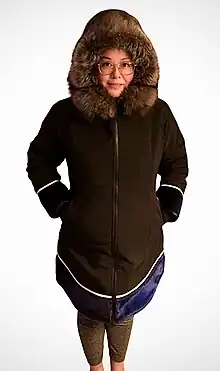
In 2013, Victoria Kakuktinniq (Inuit) founded Victoria's Arctic Fashion to market her designs. She creates fur and leather winterwear goods including headbands, jackets, gloves, and parkas, using sealskin and decorated with fox cuffs and embroidery.[29][30] In 2015, Kakuktinniq won the Business of the Year award from the Nunavut annual trade show.[31]
The Italian designing firm, Ermenegildo Zegna, opened a fashion institute in 2016, in the Azcapotzalco neighborhood of Mexico City with the goal of teaching the techniques of design to Indigenous women. Students enrolled were members of the Mazahua, Nahua, Otomí, Purépecha, Triqui and Tzeltal ethnic groups. The training the women received focused on tailoring techniques rather than on native design elements in an effort to allow the women to move from craftwork into the high fashion market.[32] That same year, Nala Peter (Inuit) began making sealskin bras and panties at the suggestion of her partner, link marketing them online and was invited to participate in the Floe Edge: Contemporary Art and Collaborations exhibition in Nunavut. Another exhibitor at the show was Nicole Camphaug (Inuit), who designs footwear with sealskin and fur heels and vamps.[33][29]
Vancouver hosted its first Indigenous Fashion Week in 2017 with designs from numerous First Nations designers, including Sho Sho Esquiro[18] (Kaska Dena/Cree), known for elaborately decorated gowns, enhanced with fur, beaver tail, salmon skin, feathers and shells combined with gold trim; Evan Ducharme (Métis), whose work focuses on sustainable and Eco-friendly design[34] and incorporates Métis elements like knotted belts based on fishing net techniques;[35] Jeneen Frei Njootli (Vuntut Gwitchin), who presented a collection using innovative design incorporating fur and hides; Autum Jules (Tlingit), noted for her use of textures and color to reflect the connection between people and the earth; Tyler-Alan Jacobs, (Squamish) whose designs reflect his identity as a two-spirit artist; and Alano Edzerza (Tahltan), known as a multi-media artist whose work incorporates silk-screened images of Native iconography on his garments.[34] Jill Setah (Yunesit'in) participated in the Vancouver event, after having showcased her works at both Oxford Fashion Week and Paris Fashion Week.[35] Tishynah Buffalo (George Gordon), who lives in Alberta, Canada, was invited to participate in London Fashion Week in 2017, to showcase her innovative designs which often use Pendleton blankets and are decorated with beadwork and Cree floral patterns.[36] Helen Oro, (Pelican Lake), who designs fashion accessories, also participated in the event. Oro who has found ceremonial beading constricting, adds beadwork to glasses, headbands, heels and creates jewelry pieces.[36][37][38]
First Nations designers, including Sage Paul (Denesuline), launched the first Indigenous Fashion Week Toronto in 2018.[39]
Legal definitions of Indigenous
After the United States passed the Indian Arts and Crafts Act of 1990, public debate in Canada over protection of intellectual property rights became a media topic. There are no Canadian laws that specifically protect against cultural appropriation. The government utilizes international agreements to uphold their fiduciary responsibility to First Nations. As in the US, laws cover communities as a whole and not individual copyright and it is difficult for Indigenous peoples to prevent misappropriation of their names and symbols. Most protections that exist are to protect economic rather than heritage rights. In two cases, trademarks have been obtained to protect Native artists. Since 1959, the "igloo tag" may be used only by Inuit to protect their works. The Cowichan Band Council has registered "Genuine Cowichan Approved" as a mark specifically for clothing designs.[40]
Canada has no specific laws to protect First Nations iconography and Indigenous arts though two trademarks, "igloo tag" and "Genuine Cowichan Approved" have been registered to protect Inuit and clothing designs for the Cowichan Tribes.
In Latin America, legislation is sparse, but some countries or individual states within countries with high Indigenous populations have passed laws to protect Indigenous heritage and design.
Controversy
Non-Native fashion designers had generated controversary by cultural misappropriation of Indigenous designs and other intellectual property. Environmentalists have also targeted some Native designers, especially Inuit, who use fur in their clothing and adornment.
In 1991, D’Arcy J. Moses (Pehdzeh Ki), whose bold colors and designs featuring beaver and other furs were carried in high-end retail stores like Holt Renfrew, Neiman Marcus and Saks Fifth Avenue, signed a contract with the Fur Council of Canada to help them improve their image, drawing anger from anti-fur activists. While the contract provided a steady income, the controversy created a distraction from his work.[41][42]
In 2017, Parisian designer Christian Louboutin drew criticism for paying Yucatec Maya artisans only 238 pesos (around $13 US) each for bags he sold for around $28,000 pesos (equivalent to $1,550 US). The controversy was sparked when activists called out Louboutin for exploiting the artisans. He paid for all of their materials and paid the workers 478 pesos per day for 6 hours of work, which compares to the average Mexican salary in the region of 80 pesos for 8 hours of work per day. The artisans were thankful for the work and the monies they received, but Louboutin's firm pulled the page advertising the bags from his website.[43][44] That same year, the Peruvian textile company Kuna withdrew a collection after complaints that the company had misappropriated kené designs from the Shipibo-Conibo people. The controversy motivated Congresswoman Tania Pariona Tarqui to introduce legislation to protect the cultural heritage and symbols of Indigenous communities in Peru.[45]
Notable Indigenous fashion designers of the Americas
- Tammy Beauvais (Kahnawake Mohawk), designed the cape given to Michelle Obama by Sophie Grégoire-Trudeau.
- Tishynah Buffalo - incorporates Cree designs
- Eliana Paco Paredes - Aymara fashion designer
See also
References
Citations
- 1 2 Gómez 2011.
- ↑ Martínez 2014.
- ↑ Kemchs 2017.
- ↑ El Diario de Chihuahua 2017.
- ↑ Falcon 2009.
- ↑ Sinopoli 2015.
- ↑ Metcalfe 2013, p. Z042.
- ↑ Hardin-Burrola, Sarath & Rosebrough 2017, p. 122.
- ↑ Metcalfe 2010, p. 237.
- ↑ Willmott 2016, p. 187.
- ↑ Durnan 2013.
- ↑ Willmott 2016, p. 188.
- ↑ Metcalfe 2010, p. 243.
- ↑ Metcalfe 2012b, p. 85.
- ↑ Bennett-Begaye 2015, p. 95.
- ↑ Grinberg 2013.
- ↑ Indyke 2001.
- 1 2 "Native American Fashion's Best of the Best Hit the Runway in Santa Fe [30 Photos] – Indian Country Media Network". indiancountrymedianetwork.com. Retrieved 2018-01-17.
- ↑ Aconcha 2014.
- ↑ Resnik 2016.
- ↑ Castellanos Usigli 2016.
- ↑ Campos L. 2016.
- ↑ Contacto Hoy 2017.
- ↑ El Telégrafo 2017.
- ↑ Prensa Libre 2016.
- ↑ Alvarado 2015.
- ↑ Márquez 2017.
- ↑ Mendieta T. 2017.
- 1 2 Indian Country Today 2017.
- ↑ Tamoto 2013.
- ↑ Zerehi 2016.
- ↑ Hernández 2016.
- ↑ McCue 2016.
- 1 2 Collie 2017.
- 1 2 Narang 2017.
- 1 2 Bell 2017.
- ↑ Mattern 2018.
- ↑ James 2017.
- ↑ Beaulne-Stuebing, Laura (26 March 2023). "Indigenous fashion designers aren't waiting for the industry to change — they're changing it themselves". CBC. Retrieved 12 November 2023.
- ↑ Udy 2015.
- ↑ Busch 2015.
- ↑ Nadeau 2005, p. 186.
- ↑ Escobar & Rodríguez 2017.
- ↑ Fregoso 2017.
- ↑ La Vanguardia 2017.
Bibliography
- Aconcha, Diana Carolina (July 2014). "De los pueblos originarios a la moda actual" [From the original peoples to current fashion] (PDF). Actas de Diseño (in Spanish). IX (17): 136–142. ISSN 1850-2032. Archived from the original (PDF) on 13 January 2018. Retrieved 13 January 2018.
- Alvarado, Ana Cristina (5 November 2015). "Churandy propone ropa de noche indígena" [Churandy proposes Indigenous evening wear] (in Spanish). Quito, Ecuador: El Comercio. Archived from the original on 7 November 2015. Retrieved 13 January 2018.
- Avila, Theresa (30 December 2015). "Native American Designers Are Behind More Clothes Than You May Realize". New York City, New York: Mic. Retrieved 8 January 2018.
- Begley, Maggie (6 March 2003). "Grammy Fest party in New York attracts top Indian talent". Indian Country Today. New York City, New York. Archived from the original on 8 September 2017. Retrieved 12 January 2018.
- Bell, Roberta (4 February 2017). "Alberta Indigenous designer to showcase culture during London Fashion Week". Toronto, Ontario, Canada: CBC News. Archived from the original on 13 January 2018. Retrieved 14 January 2018.
- Bennett-Begaye, Jourdan (July 2015). "What Is Truly Native?". Native People's Magazine. 28 (4): 93–97. Retrieved 10 January 2018 – via EBSCOhost.
- Bhasin, Kim (27 January 2015). "Ralph Lauren's Native American Ads Reveal Sad Truth About The Fashion World". Huffington Post. Archived from the original on 1 July 2017. Retrieved 11 January 2018.
- Brown, Herman (8 June 2016). "Art—a family tradition". Okmulgee, Oklahoma: Okmulgee Times. Archived from the original on 8 January 2018. Retrieved 8 January 2018.
- Busch, Laura (1 October 2015). "D'arcy Moses' Big Bet". Up Here. Yellowknife, Northwest Territories, Canada: Up Here Publishing. ISSN 0828-4253. Archived from the original on 30 June 2017. Retrieved 10 January 2018.
- Campos L., Paula (25 July 2016). "Voz, la innovadora marca que une artesanía chilena con diseños de lujo" [Voz, the innovative brand that unites Chilean crafts with luxury designs]. Harper's Bazaar (in Spanish). Mexico City, Mexico: Hearst Magazines, Televisa. ISSN 0017-7873. Archived from the original on 30 July 2016. Retrieved 13 January 2018.
- Castellanos Usigli, Talía (19 August 2016). "Cómo 4 marcas de moda acercan el trabajo artesanal a los millennials" [How 4 fashion brands bring craftsmanship to millennials]. Vogue (in Spanish). Mexico City, Mexico: Condé Nast. ISSN 0042-8000. Archived from the original on 29 October 2016. Retrieved 13 January 2018.
- Collie, Meghan (26 July 2017). "10 Designers to Watch at Vancouver Indigenous Fashion Week". Flare. Toronto, Ontario, Canada: Rogers Media. ISSN 0708-4927. Retrieved 14 January 2018.
- Deerchild, Rosanna (18 December 2016). "Unreserved: Fashion designer Dorothy Grant has been sharing Haida legends for 30 years". Ottawa, Ontario, Canada: CBC Radio. Archived from the original on 6 November 2017. Retrieved 8 January 2018.
- Durnan, Matt (24 April 2013). "Building confidence in youth: David Jones visits Thompson". Thompson, Manitoba, Canada: Thompson Citizen. Archived from the original on 10 January 2018. Retrieved 10 January 2018.
- Escobar, Isamar; Rodríguez, Jazmín (8 July 2017). "A indígenas mayas les pagan 200 pesos por adornar bolsas de 28 mil" [Mayan Indians are paid 200 pesos to decorate bags worth 28 thousand pesos]. El Universal (in Spanish). Mexico City, Mexico. Archived from the original on 13 January 2018. Retrieved 13 January 2018.
- Falcon, Janine (23 July 2009). "First Nation old world meets new with these aboriginal fashion designers". Toronto, Ontario, Canada: Toronto Metro News. Metro International. Archived from the original on 30 June 2016. Retrieved 12 January 2018.
- Fregoso, Juliana (5 August 2017). "Polémica en México por el trabajo de un diseñador top de moda francés con artesanos mayas" [Controversy in Mexico for the work of a top French fashion designer with Mayan artisans] (in Spanish). Argentina: Infobae. Archived from the original on 5 August 2017. Retrieved 13 January 2018.
- Gilger, Lauren (19 October 2011). "Urban Outfitters Pulls Navajo Name from Collection; Heard Museum Weighs In on Native-Inspired Fashion That Should Be Produced". Phoenix New Times. Archived from the original on 11 January 2018. Retrieved 11 January 2017.
- Gómez, Adriana (17 November 2011). "Moda indígena inspira pasarelas en México" [Indigenous fashion inspires catwalks in Mexico] (in Spanish). Santiago, Chile: Emol. Associated Press. Archived from the original on 14 January 2018. Retrieved 14 January 2018.
- Grinberg, Emanuella (4 June 2014). "Native American designers fight cultural caricatures". Atlanta, Georgia: CNN. Archived from the original on 13 August 2014. Retrieved 12 January 2018.
- Grinberg, Emanuella (1 April 2013). "Taking Native American fashion 'Beyond Buckskin' and headdresses". CNN. Archived from the original on 10 May 2016. Retrieved 10 January 2017.
- Hardin-Burrola, Elizabeth; Sarath, Carol; Rosebrough, Bob (2017). Legendary Locals of Gallup. Charleston, South Carolina: Arcadia Publishing Incorporated. ISBN 978-1-4396-6344-8.
- Haywood, Phaedra (13 March 2015). "Jeri Ah-be-hill, 1934–2015: Indigenous fashion aficionado was 'a giant in honoring her native culture'". The Santa Fe New Mexican. Santa Fe, New Mexico. Retrieved 8 January 2018.
- Hernández, Sandra (23 October 2016). "Son Zegna. Indígenas en la alta costura" [They are Zegna: Indigeous women in high fashion]. El Universal (in Spanish). Mexico City, Mexico. Archived from the original on 18 March 2017. Retrieved 14 January 2018.
- Indyke, Dottie (May 2001). "Jamie Okuma". Native Arts. Archived from the original on 31 December 2015. Retrieved 10 January 2018.
- James, Thia (13 January 2017). "Helen Oro cutting a figure with confidence in fashion world". Saskatoon, Saskatchewan, Canada: Saskatoon StarPhoenix. Archived from the original on 1 June 2017. Retrieved 14 January 2018.
- Kemchs, Christian (17 May 2017). "El sastre mixteco de los poderosos" [The Mixtec tailor for the powerful]. El Universal (in Spanish). Mexico City, Mexico. Archived from the original on 10 June 2017. Retrieved 14 January 2018.
- Latimer, Kendal (25 August 2016). "Sask. Indigenous fashion designer to debut on New York runway". Toronto, Ontario, Canada: CBC News. Archived from the original on 16 May 2017. Retrieved 16 January 2018.
- Leavitt, Peter A.; Covarrubias, Rebecca; Perez, Yvonne A.; Fryberg, Stephanie A. (2015-03-01). "'Frozen in Time': The Impact of Native American Media Representations on Identity and Self-Understanding". Journal of Social Issues. 71 (1): 39–53. doi:10.1111/josi.12095. ISSN 1540-4560.
- Lefevre, Camille (August 2016). "Native Threads". American Craft. 76 (4): 20–21 – via EBSCOhost.
- Lieber, Chavie (21 January 2016). "The Reclaiming of Native American Fashion". Racked. Washington, D. C.: Vox Media. Archived from the original on 5 January 2018. Retrieved 9 January 2018.
- Leighty, John M. (21 July 1986). "Native American designs go high fashion;NEWLN:Traditional Lakota patterns adorn contemporary evening wear". Boca Raton, Florida. UPI. Archived from the original on 11 January 2018. Retrieved 11 January 2018.
- Livingston, Joan (9 October 2013). "Citizen of the Year: Patricia Michaels". The Taos News. Taos, New Mexico. Archived from the original on 8 January 2018. Retrieved 8 January 2018.
- López, Santana (15 August 2007). "Breaking Out: Six artists use prestigious award as opportunity to move forward (pt 1)". The Santa Fe New Mexican. Santa Fe, New Mexico. p. Z072. Retrieved 8 January 2018 – via Newspapers.com.
 , López, Santana (15 August 2007). "Breaking Out: Six artists use prestigious award as opportunity to move forward (pt. 2)". The Santa Fe New Mexican. Santa Fe, New Mexico. p. Z044. Retrieved 8 January 2018 – via Newspapers.com.
, López, Santana (15 August 2007). "Breaking Out: Six artists use prestigious award as opportunity to move forward (pt. 2)". The Santa Fe New Mexican. Santa Fe, New Mexico. p. Z044. Retrieved 8 January 2018 – via Newspapers.com.  and López, Santana (15 August 2007). "Breaking Out: Six artists use prestigious award as opportunity to move forward (pt. 3)". The Santa Fe New Mexican. Santa Fe, New Mexico. p. Z074. Retrieved 8 January 2018 – via Newspapers.com.
and López, Santana (15 August 2007). "Breaking Out: Six artists use prestigious award as opportunity to move forward (pt. 3)". The Santa Fe New Mexican. Santa Fe, New Mexico. p. Z074. Retrieved 8 January 2018 – via Newspapers.com. 
- Márquez, Cristina (1 August 2017). "Sus diseños tienen la identidad puruhá" [Her designs have puruhá identity]. Revista Líderes (in Spanish). Quito, Ecuador: El Comercio. Archived from the original on 13 January 2018. Retrieved 13 January 2018.
- Martínez, Myrna I. (1 June 2014). "Un mexicano, entre los mejores sastres del mundo" [A Mexican, among the best tailors of the world] (in Spanish). Mexico City, Mexico: El Financiero. Archived from the original on 14 July 2017. Retrieved 14 January 2018.
- Matera, Avery (22 November 2017). "VS Fashion Show 2017 Slammed for Cultural Appropriation". Teen Vogue. Archived from the original on 1 December 2017. Retrieved 11 January 2017.
- Mattern, Ashleigh (5 January 2018). "Sask. Indigenous designer heading to Hollywood". Toronto, Ontario, Canada: CBC News. Archived from the original on 14 January 2018. Retrieved 14 January 2018.
- McCue, Duncan (14 March 2016). "Putting sexy back in sealskin: Nunavut seamstresses aim for high-end fashion market". Toronto, Ontario, Canada: CBC News. Archived from the original on 19 March 2017. Retrieved 18 January 2018.
- Mendieta T., José A. (11 August 2017). "Moda indígena en Ecuador: para no negar la identidad" [Indigenous fashion in Ecuador: no denial of identity]. Distintas Latitudes (in Spanish). Mexico City, Mexico. Archived from the original on 13 January 2018. Retrieved 13 January 2018Wordpress publication with an editorial board and curated content
{{cite magazine}}: CS1 maint: postscript (link) - Metcalfe, Jessica R. (July 2012b). "Native Couture". Native Peoples Magazine. 25 (4): 84–86. Retrieved 10 January 2018 – via EBSCOhost.
- Metcalfe, Jessica RheAnn (2010). Native Designers of High Fashion: Expressing Identity, Creativity, and Tradition in Contemporary Customary Clothing Design (PhD). Tucson, Arizona: The University of Arizona. hdl:10150/194057.
- Metcalfe, Jessica R. (11 August 2013). "Native high fashion: then, now and into the future (pt. 1)". The Santa Fe New Mexican. Santa Fe, New Mexico. p. Z042. Retrieved 8 January 2018 – via Newspapers.com.
 , Metcalfe, Jessica R. (11 August 2013). "Native high fashion: then, now and into the future (pt. 2)". The Santa Fe New Mexican. Santa Fe, New Mexico. p. Z044. Retrieved 8 January 2018 – via Newspapers.com.
, Metcalfe, Jessica R. (11 August 2013). "Native high fashion: then, now and into the future (pt. 2)". The Santa Fe New Mexican. Santa Fe, New Mexico. p. Z044. Retrieved 8 January 2018 – via Newspapers.com.  and Metcalfe, Jessica R. (11 August 2013). "Native high fashion: then, now and into the future (pt. 3)". The Santa Fe New Mexican. Santa Fe, New Mexico. p. Z045. Retrieved 8 January 2018 – via Newspapers.com.
and Metcalfe, Jessica R. (11 August 2013). "Native high fashion: then, now and into the future (pt. 3)". The Santa Fe New Mexican. Santa Fe, New Mexico. p. Z045. Retrieved 8 January 2018 – via Newspapers.com. 
- Monks, Vicki (Winter 2016). "Margaret Roach Wheeler Chickasaw Textile Artist". First American Art Magazine (13): 70–75. ISSN 2333-5548.
- Nadeau, Chantal (2005). Fur Nation: From the Beaver to Brigitte Bardot. London, England: Routledge. ISBN 978-1-134-72482-6.
- Narang, Sonia (20 September 2017). "These photos show the strength and beauty of aboriginal cultures in Canada". Minneapolis, Minnesota: Public Radio International. Archived from the original on 9 January 2018. Retrieved 16 January 2018.
- Parezo, Nancy J.; Jones, Angelina R. (June 2009). "What's in a Name?: The 1940s–1950s 'Squaw Dress'". American Indian Quarterly. 33 (3): 373–404. doi:10.1353/aiq.0.0058. S2CID 162233209.
- Phinney, Susan (19 January 2005). "Designer streamlines a bulky wool coat with a sleek fit and stunning designs". Seattle Post-Intelligencer. Seattle, Washington. Archived from the original on 11 January 2018. Retrieved 11 January 2018.
- Reid, Betty (28 July 1999). "Navajo women lay claim to world of fashion (pt 1)". The Arizona Republic. Phoenix, Arizona. p. 31. Retrieved 18 January 2018 – via Newspapers.com.
 and Reid, Betty (28 July 1999). "Navajo designers gaining share of fashion market (pt 2)". The Arizona Republic. Phoenix, Arizona. p. 35. Retrieved 18 January 2018 – via Newspapers.com.
and Reid, Betty (28 July 1999). "Navajo designers gaining share of fashion market (pt 2)". The Arizona Republic. Phoenix, Arizona. p. 35. Retrieved 18 January 2018 – via Newspapers.com. 
- Resnik, Jaqueline (12 September 2016). "Cómo ayuda la moda a las artesanas mexicanas" [How fashion helps Mexican artisans]. Forbes (in Spanish). New York, New York. ISSN 0015-6914. Archived from the original on 13 January 2018. Retrieved 13 January 2018.
- Ross, Jenna (2 November 2017). "Tiny North Dakota town a stylemaker's home base". Reading Eagle Company. Archived from the original on November 2, 2017. Retrieved 10 January 2018.
- Sinha-Roy, Piya (4 November 2012). Simao, Paul (ed.). "No Doubt apologize to Native Americans for Wild West video". Reuters. London, England. Archived from the original on 12 January 2018. Retrieved 12 January 2018.
- Sinopoli, Danny (12 June 2015). "How a little company from Manitoba is taking over the world one moccasin at a time". The Globe and Mail. Toronto, Ontario, Canada. Archived from the original on 12 January 2018. Retrieved 12 January 2018.
- Schmitt, Rory O'Neill (2016). Navajo and Hopi Art in Arizona: Continuing Traditions. Charleston, South Carolina: Arcadia Publishing Incorporated. ISBN 978-1-62585-560-2.
- Silversmith, Shondiin (31 October 2013). "Fashion show honors great Native women". Navajo Times. Window Rock, Arizona. Archived from the original on 4 November 2013. Retrieved 18 January 2018.
- Tamoto, Connie (30 November 2013). "Exploring the Arctic". Winnipeg Free Press. Winnipeg, Manitoba, Canada. Archived from the original on 18 January 2018. Retrieved 18 January 2018.
- Udy, Vanessa (19 November 2015). "The Appropriation of Aboriginal Cultural Heritage: Examining the Uses and Pitfalls of the Canadian Intellectual Property Regime". Intellectual Property Issues in Cultural Heritage. Vancouver, British Columbia, Canada: Simon Fraser University. Archived from the original on 1 April 2016. Retrieved 12 January 2018.
- Walker, Jenn (19 October 2013). "The Woman Who Wears the Dress". Globe, Arizona: Globe Miami Times. Archived from the original on 18 January 2018. Retrieved 18 January 2018.
- Willmott, Corey (2016). "8. Designing, Producing and Enacting Nationalisms: Contemporary Amerindian Fashions in Canada". In Lemire, Beverly (ed.). The Force of Fashion in Politics and Society: Global Perspectives from Early Modern to Contemporary Times. New York, New York: Taylor & Francis. pp. 167–190. ISBN 978-1-351-88969-8.
- Zerehi, Sima Sahar (19 September 2016). "25th annual Nunavut trade show and conference opens in Iqaluit". Toronto, Ontario, Canada: CBC News. Archived from the original on 23 December 2016. Retrieved 18 January 2018.
- "Artesanías de indígenas colombianos y moda se fusionan en feria BCapital" [Indigenous Colombian crafts and fashion merge at Bogotá Capital fair] (in Spanish). Durango, Mexico: Contacto Hoy. 20 October 2017. Archived from the original on 13 January 2018. Retrieved 13 January 2018.
- "Clothing that's cultural". The Arizona Republic. Phoenix, Arizona. 14 January 2002. p. 78. Retrieved 18 January 2018 – via Newspapers.com.

- "Design Studio: Angela Demontigny". West of the City Magazine. Mississauga, Ontario, Canada: Metroland Media Group Ltd. 10 November 2016. Archived from the original on 12 January 2018. Retrieved 12 January 2018.
- "Diseñadora aimara boliviana presenta nueva colección" [Bolivian aimara designer presents new collection]. Prensa Libre (in Spanish). Guatemala City, Guatemala. EFE. 16 July 2016. Archived from the original on 17 October 2016. Retrieved 13 January 2018.
- "El sastre indígena que confecciona la ropa de los poderosos en México" [The indigenous tailor who makes the clothes for the powerful in Mexico] (in Spanish). Chihuahua, Mexico: El Diario de Chihuahua. 6 October 2017. Archived from the original on 7 October 2017. Retrieved 14 January 2018.
- "Indian Fashions Are Unique". The Missoulian. Missoula, Montana. 3 July 1973. p. 5. Retrieved 10 January 2018 – via Newspapers.com.

- "Inuit Designers Revive Sealskin Fashion, Celebrate 'National Seal Products Day', May 20". Indian Country Today. New York City, New York. 20 May 2017. Archived from the original on 18 January 2018. Retrieved 18 January 2018.
- "Jewel Gilham exhibits fashions". Kalispell, Montana: Daily Inter Lake. 1 May 1977. p. 14. Retrieved 10 January 2018 – via Newspapers.com.

- "La moda indígena florece en Ecuador" [Indigenous fashion flourishes in Ecuador] (in Spanish). Guayaquil, Ecuador: El Telégrafo. Agence France-Presse. 14 July 2017. Archived from the original on 13 January 2018. Retrieved 13 January 2018.
- "Retiran colección de moda acusada de apropiarse de arte de indígenas peruanos" [Retracted fashion collection accused of appropriating Peruvian indigenous art]. La Vanguardia (in Spanish). Barcelona, Spain. EFE. 18 September 2017. Retrieved 13 January 2018.
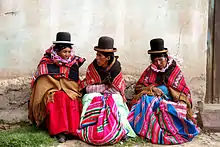
.jpg.webp)

